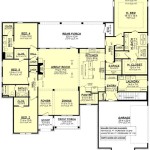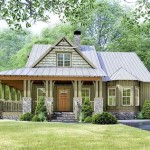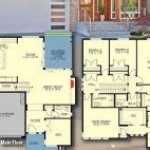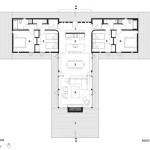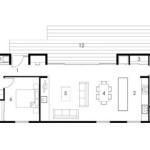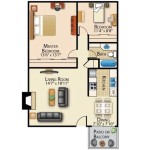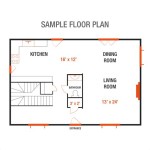An open plan house, also known as an open-concept house, is a type of house where the traditional division of space into separate rooms is eliminated or minimized, creating a more fluid and spacious living environment. The core function of an open plan house is to create a sense of spaciousness and openness, allowing for a more flexible and versatile use of space. A real-world example of an open plan house is a modern loft apartment, where the living room, kitchen, and dining room are all combined into one large, open space.
Open plan houses offer several benefits, including increased natural light, improved air circulation, and a greater sense of community. The absence of walls or partitions allows for a better flow of light and air, creating a more comfortable and inviting living environment. Additionally, open plan houses encourage interaction and communication between family members, as everyone can be easily seen and heard from any point in the house.
In the following sections, we will explore the advantages and disadvantages of open plan houses in more detail, discussing their impact on space, privacy, and the overall quality of life. We will also provide tips on how to design an open plan house that meets your specific needs and preferences.
Here are 8 important points about open plan houses:
- Spacious and open
- Increased natural light
- Improved air circulation
- Greater sense of community
- Flexible and versatile
- Can be noisy and lack privacy
- May require more cleaning and maintenance
- Not suitable for all families and lifestyles
Open plan houses offer several benefits, including increased space, natural light, and air circulation. They can also create a greater sense of community and togetherness. However, it is important to consider the potential drawbacks of open plan living, such as noise, lack of privacy, and the need for more cleaning and maintenance. Ultimately, the decision of whether or not an open plan house is right for you depends on your individual needs and preferences.
Spacious and open
One of the main benefits of an open plan house is its spaciousness and openness. The elimination of walls and partitions creates a more fluid and continuous living environment, making the house feel larger and more airy. This is especially beneficial in smaller homes, where every square foot of space is valuable. Open plan houses also allow for a more flexible and versatile use of space. For example, you could use the same space for multiple purposes, such as cooking, dining, and entertaining.
The spaciousness and openness of open plan houses also contributes to a more comfortable and inviting living environment. The absence of walls or partitions allows for a better flow of light and air, creating a brighter and more welcoming space. Additionally, open plan houses encourage interaction and communication between family members, as everyone can be easily seen and heard from any point in the house.
However, it is important to note that open plan houses are not always suitable for everyone. For example, people who value privacy or who need a quiet space to work or study may find open plan living to be too noisy and distracting. Additionally, open plan houses can be more difficult to keep clean and tidy, as there are no walls or partitions to hide clutter.
Overall, open plan houses offer a number of advantages, including increased space, natural light, and air circulation. They can also create a greater sense of community and togetherness. However, it is important to consider the potential drawbacks of open plan living, such as noise, lack of privacy, and the need for more cleaning and maintenance. Ultimately, the decision of whether or not an open plan house is right for you depends on your individual needs and preferences.
Increased natural light
One of the main benefits of an open plan house is its increased natural light. The elimination of walls and partitions allows for more windows and doors, which means that more natural light can enter the house. This creates a brighter and more welcoming living environment, and can also help to reduce energy costs by reducing the need for artificial lighting.
- More windows and doors
Open plan houses typically have more windows and doors than traditional houses, as there are no walls or partitions to obstruct the flow of light. This allows for more natural light to enter the house, creating a brighter and more inviting living environment.
- Larger windows
Open plan houses also tend to have larger windows than traditional houses. This is because there are no walls or partitions to support the weight of the windows, so larger windows can be used without compromising the structural integrity of the house.
- Fewer obstructions
In a traditional house, walls and partitions can obstruct the flow of light, creating dark and shadowy areas. In an open plan house, there are fewer obstructions, so the natural light can flow more freely throughout the house.
- Reduced need for artificial lighting
The increased natural light in an open plan house can help to reduce the need for artificial lighting, which can save energy and money. Additionally, natural light has been shown to have a number of benefits for human health, including improved mood, increased productivity, and better sleep.
Overall, the increased natural light in an open plan house is a major benefit that can make the house more comfortable, inviting, and energy-efficient.
Improved air circulation
Another benefit of an open plan house is its improved air circulation. The elimination of walls and partitions allows air to flow more freely throughout the house, creating a more comfortable and healthy living environment.
- No barriers to airflow
In a traditional house, walls and partitions can create barriers to airflow, making it difficult for air to circulate throughout the house. In an open plan house, there are no such barriers, so air can flow more freely from one room to another.
- Cross-ventilation
Open plan houses often have windows and doors on opposite sides of the house, which allows for cross-ventilation. This is when air flows through the house from one side to the other, creating a cooling effect and improving air quality.
- Reduced humidity
The improved air circulation in an open plan house can help to reduce humidity levels. This is because the air is able to circulate more freely and carry away moisture from the house. Reduced humidity levels can help to prevent the growth of mold and mildew, and can also make the house feel more comfortable, especially in hot and humid climates.
- Improved indoor air quality
The improved air circulation in an open plan house can also help to improve indoor air quality. This is because the air is able to circulate more freely and carry away pollutants, such as dust, pollen, and pet dander. Improved indoor air quality can help to reduce the risk of respiratory problems, such as asthma and allergies.
Overall, the improved air circulation in an open plan house is a major benefit that can make the house more comfortable, healthy, and energy-efficient.
Greater sense of community
One of the main benefits of an open plan house is its greater sense of community. The elimination of walls and partitions creates a more open and inviting space, where family members and friends can interact and connect with each other more easily.
In a traditional house, walls and partitions can create a sense of separation between different rooms. This can make it difficult for family members to communicate and interact with each other, especially if they are in different parts of the house. In an open plan house, there are no such barriers, so family members can easily see, hear, and interact with each other, even if they are in different parts of the house.
The greater sense of community in an open plan house can be beneficial for families in a number of ways. For example, it can help to strengthen family bonds, as family members are more likely to spend time together and interact with each other. It can also help to improve communication and cooperation between family members, as they are more likely to be aware of each other’s needs and activities.
In addition to families, open plan houses can also create a greater sense of community among friends and neighbors. For example, if you have an open plan house, you may be more likely to invite friends and neighbors over for dinner or drinks, as you will have more space to entertain guests. Additionally, the open and inviting nature of an open plan house can make it more likely that neighbors will stop by for a chat or to borrow a cup of sugar.
Overall, the greater sense of community in an open plan house is a major benefit that can make the house a more comfortable, inviting, and enjoyable place to live.
Flexible and versatile
Another major benefit of open plan houses is their flexibility and versatility. The elimination of walls and partitions allows for a more flexible and adaptable use of space, making open plan houses ideal for a variety of lifestyles and needs.
- Multi-purpose spaces
Open plan houses allow for the creation of multi-purpose spaces that can be used for a variety of different activities. For example, a living room can also be used as a dining room or a home office, and a kitchen can also be used as a breakfast nook or a family room. This flexibility is especially beneficial in smaller homes, where every square foot of space needs to be used wisely.
- Adaptable to changing needs
Open plan houses are also adaptable to changing needs over time. For example, if you have a young family, you may need more space for play and activities. As your children grow older, you may need more space for studying or entertaining. An open plan house can be easily adapted to meet your changing needs, without the need for major renovations.
- Easy to reconfigure
Open plan houses are also easy to reconfigure, as there are no walls or partitions to obstruct the flow of space. This makes it easy to change the layout of your house to suit your changing needs or preferences. For example, you could move the kitchen to a different part of the house, or add a new room without having to make major structural changes.
- Increased creativity
The flexibility and versatility of open plan houses can also inspire creativity. Without the constraints of walls and partitions, you are free to design a house that is truly unique and personal to you. For example, you could create a home office that is also a library, or a kitchen that is also a dining room and family room.
Overall, the flexibility and versatility of open plan houses is a major benefit that makes them ideal for a variety of lifestyles and needs. Open plan houses are adaptable to changing needs, easy to reconfigure, and can inspire creativity.
In addition to the flexibility and versatility of the space itself, open plan houses also offer greater flexibility in terms of furniture and dcor. For example, you can use furniture to divide up the space into different zones, or you can use rugs and curtains to create different moods and atmospheres. The possibilities are endless, and you are only limited by your own imagination.
Can be noisy and lack privacy
While open plan houses offer many benefits, there are also some potential drawbacks to consider. One potential drawback is that open plan houses can be noisy, as there are no walls or partitions to absorb sound. This can be a problem for people who need a quiet space to work or study, or for families with young children who need to sleep.
Another potential drawback of open plan houses is that they can lack privacy. This is because there are no walls or partitions to create separate rooms, so it can be difficult to find a private space to relax or to have a conversation. This can be a problem for people who value their privacy, or for families with teenagers who need their own space.
- Noise travels easily
In an open plan house, sound can travel easily from one room to another. This can be a problem if you have different activities happening in different parts of the house, such as someone watching TV in the living room while someone else is trying to sleep in the bedroom. The lack of walls or partitions means that sound can travel freely throughout the house, making it difficult to create quiet spaces.
- Lack of privacy
Another potential drawback of open plan houses is that they can lack privacy. This is because there are no walls or partitions to create separate rooms, so it can be difficult to find a private space to relax or to have a conversation. This can be a problem for people who value their privacy, or for families with teenagers who need their own space.
- Distractions
The open and airy nature of open plan houses can also be a source of distractions. For example, if you are trying to work in the living room, you may be distracted by the TV in the next room. Additionally, the lack of walls or partitions can make it difficult to create separate spaces for different activities, such as a quiet space for reading or a dedicated playroom for children.
- Solutions
There are a number of things that can be done to mitigate the noise and privacy concerns associated with open plan houses. For example, you can use rugs and curtains to absorb sound, and you can use furniture to create separate zones for different activities. Additionally, you can install soundproofing materials in the walls and ceilings to reduce noise transmission. However, it is important to note that these solutions may not completely eliminate noise and privacy concerns, so it is important to carefully consider your needs before choosing an open plan house.
Overall, open plan houses offer a number of benefits, but there are also some potential drawbacks to consider, such as noise and lack of privacy. It is important to carefully weigh the pros and cons before deciding whether an open plan house is right for you.
May require more cleaning and maintenance
Open plan houses can require more cleaning and maintenance than traditional houses, as there are no walls or partitions to break up the space. This means that dirt and dust can travel more easily throughout the house, and there are more surfaces to clean. Additionally, the open and airy nature of open plan houses can make it more difficult to keep the house at a comfortable temperature, as heat and cold can travel more easily throughout the house.
- More surfaces to clean
One of the main reasons why open plan houses require more cleaning and maintenance is that there are more surfaces to clean. This includes not only the floors and windows, but also the countertops, cabinets, and furniture. Additionally, the open and airy nature of open plan houses can make it more difficult to keep dust from settling on surfaces, so you may need to dust more frequently.
- Dirt and dust can travel more easily
In a traditional house, walls and partitions can help to prevent dirt and dust from traveling from one room to another. However, in an open plan house, there are no such barriers, so dirt and dust can travel more easily throughout the house. This means that you may need to clean more frequently, especially in high-traffic areas.
- More difficult to keep the house at a comfortable temperature
The open and airy nature of open plan houses can make it more difficult to keep the house at a comfortable temperature. This is because heat and cold can travel more easily throughout the house, so you may need to adjust the thermostat more frequently. Additionally, open plan houses can be more drafty than traditional houses, so you may need to use more weatherstripping and caulking to keep the cold air out.
- Increased wear and tear
Open plan houses can also experience more wear and tear than traditional houses. This is because there are no walls or partitions to protect the floors, furniture, and other surfaces from damage. For example, children and pets may be more likely to run and play in an open plan house, which can lead to more wear and tear on the floors and furniture.
Overall, open plan houses can require more cleaning and maintenance than traditional houses. This is due to the increased number of surfaces to clean, the increased potential for dirt and dust to travel throughout the house, the difficulty in keeping the house at a comfortable temperature, and the increased wear and tear on the floors, furniture, and other surfaces.
Not suitable for all families and lifestyles
Families with young children
Open plan houses can be challenging for families with young children, as there is less privacy and it can be difficult to keep an eye on children from all parts of the house. Additionally, the open and airy nature of open plan houses can make it difficult to create separate spaces for different activities, such as a quiet space for reading or a dedicated playroom for children.
Families with teenagers
Open plan houses can also be challenging for families with teenagers, as teenagers often need their own space and privacy. The lack of walls or partitions in an open plan house can make it difficult for teenagers to find a private space to relax or to have friends over. Additionally, the open and airy nature of open plan houses can make it difficult for teenagers to have their own space to study or to pursue their hobbies.
People who value their privacy
Open plan houses are not suitable for people who value their privacy, as there is less privacy in an open plan house than in a traditional house. The lack of walls or partitions means that there is less separation between different parts of the house, so it can be difficult to find a private space to relax or to have a conversation. Additionally, the open and airy nature of open plan houses can make it difficult to create separate spaces for different activities, such as a quiet space for reading or a dedicated home office.
People who need a quiet space to work or study
Open plan houses can be challenging for people who need a quiet space to work or study, as there is less privacy and it can be more difficult to concentrate in an open and airy space. Additionally, the open and airy nature of open plan houses can make it difficult to create separate spaces for different activities, such as a quiet space for reading or a dedicated home office.
Overall, open plan houses are not suitable for all families and lifestyles. They can be challenging for families with young children or teenagers, people who value their privacy, and people who need a quiet space to work or study. It is important to carefully consider your needs and lifestyle before deciding whether an open plan house is right for you.










Related Posts

